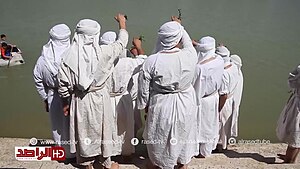| Part of a series on |
| Mandaeism |
|---|
 |
| Religion portal |

In Mandaeism, the klila (Classical Mandaic: ࡊࡋࡉࡋࡀ) is a small myrtle (Classical Mandaic: ࡀࡎࡀ, romanized: asa) wreath or ring (translated as "circlet" by E. S. Drower[1]) used during Mandaean religious rituals. The klila is a female symbol that complements the taga, a white crown which always takes on masculine symbolism.[2][3]
The klila is used to adorn the drabsha, a wooden cross covered with a white cloth that is the main symbol of Mandaeism.[2]
- ^ Cite error: The named reference
Drower 1959was invoked but never defined (see the help page). - ^ a b Buckley, Jorunn Jacobsen (2002). The Mandaeans: ancient texts and modern people. New York: Oxford University Press. ISBN 0-19-515385-5. OCLC 65198443.
- ^ Drower, Ethel Stefana (1937). The Mandaeans of Iraq and Iran. Oxford at the Clarendon Press.
© MMXXIII Rich X Search. We shall prevail. All rights reserved. Rich X Search
